United has been moving towards a premium-heavy strategy. The offer more international business class seats than peers using similar aircraft, and they’ve invested in really nice international business class lounges.
Their Polaris business class seat allows them to do this because it gives them a fully flat product with direct aisle access without taking up more space in the cabin than their old six-abreast seats. It’s a “good enough” seat that isn’t quite as nice as American’s B/E Aerospace Super Diamond or Delta’s new Suites, but that doesn’t require actively avoiding flying business class on United.
United has announced a doubling down on the premium heavy approach adding even more business class seats to a subfleet of 767-300s, as well as adding first class seats to Airbus A319 and A320s where they’ve had fewer seats up front than competitors. And they’re introducing an all-new regional jet configuration with just 50 seats in an aircraft normally outfitted with 70.
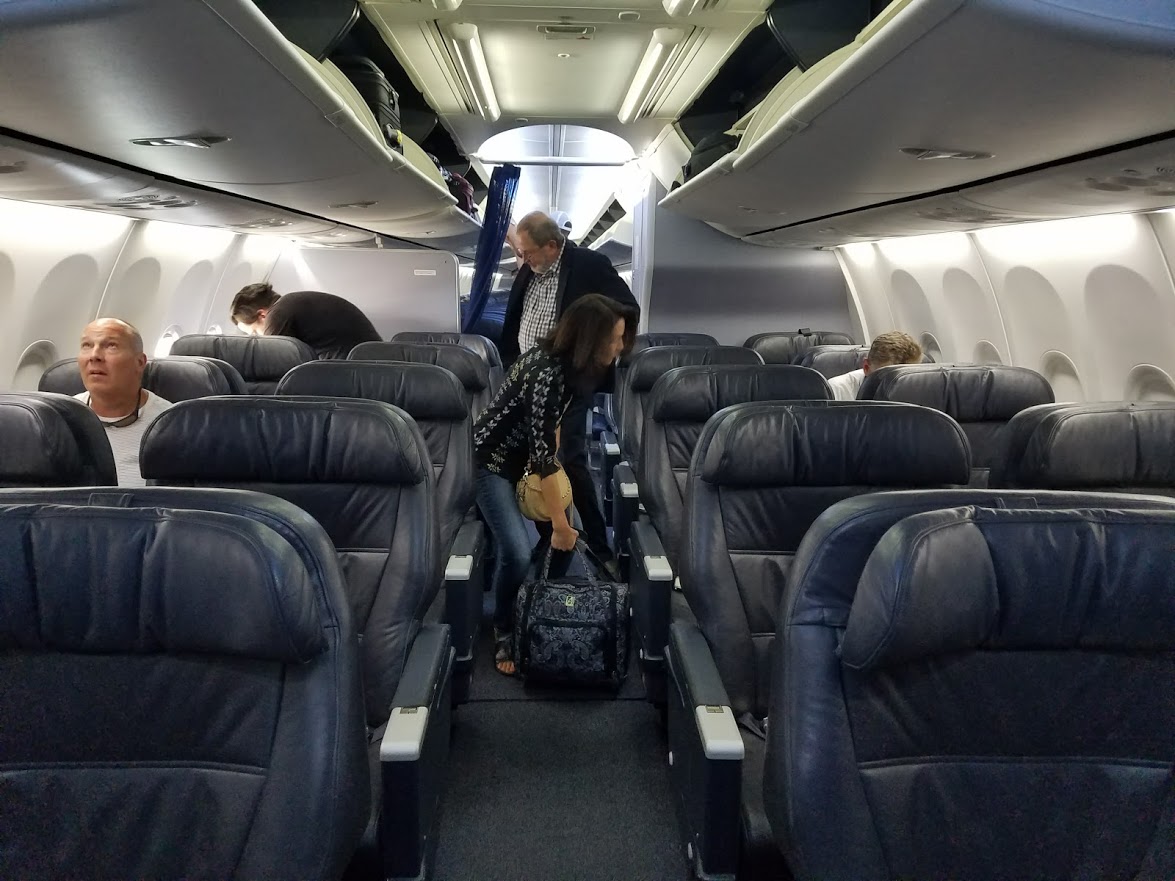
More First Class Seats on Airbus Narrowbodies
United will add four first class seats to each of their Airbus A319s and Airbus A320s.
- A319s go from 8 first class seats to 12. They’re effectively replacing a row of Economy Plus (6 seats) with a row of First (4 seats), so the aircraft will have two fewer seats. Still those inches have to come from somewhere for instance we’ll see whether first is losing an inch of legroom.
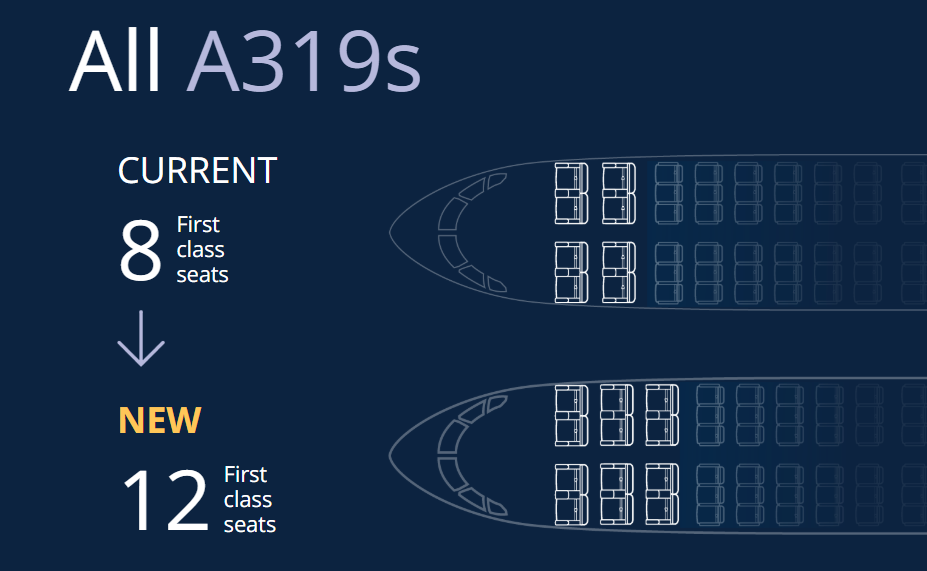
- A320s go from 12 first class seats to 16. The aircraft will have the same total number of seats, with Economy Plus losing 3 and coach losing 1. It will be interesting to see whether the extra inches in first are noticeably lost elsewhere.
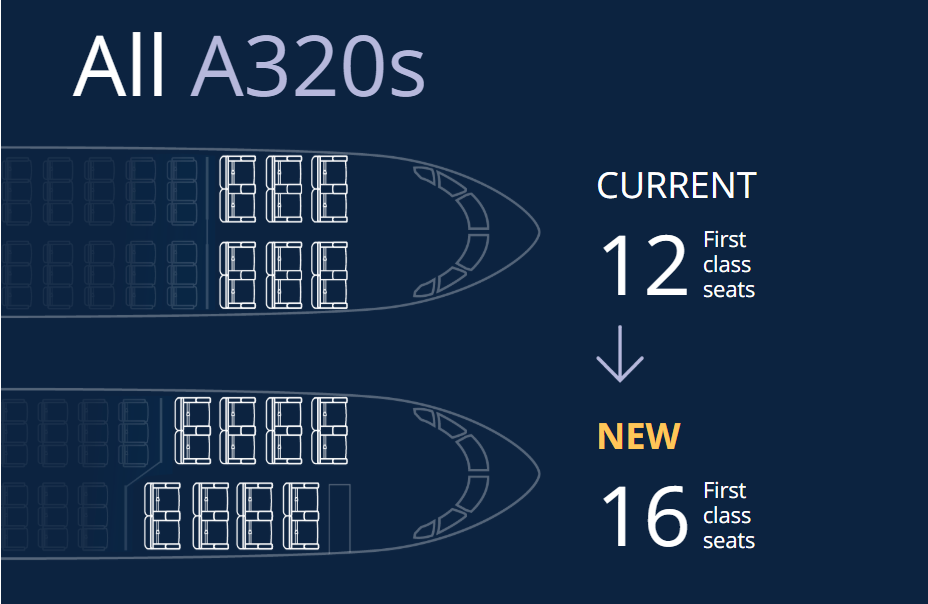
More Business Class Seats on Some Boeing 767s
United is expanding business class on 21 of its Boeing 767-300ERs from 30 to 46 seats, along with 21 premium economy seats.
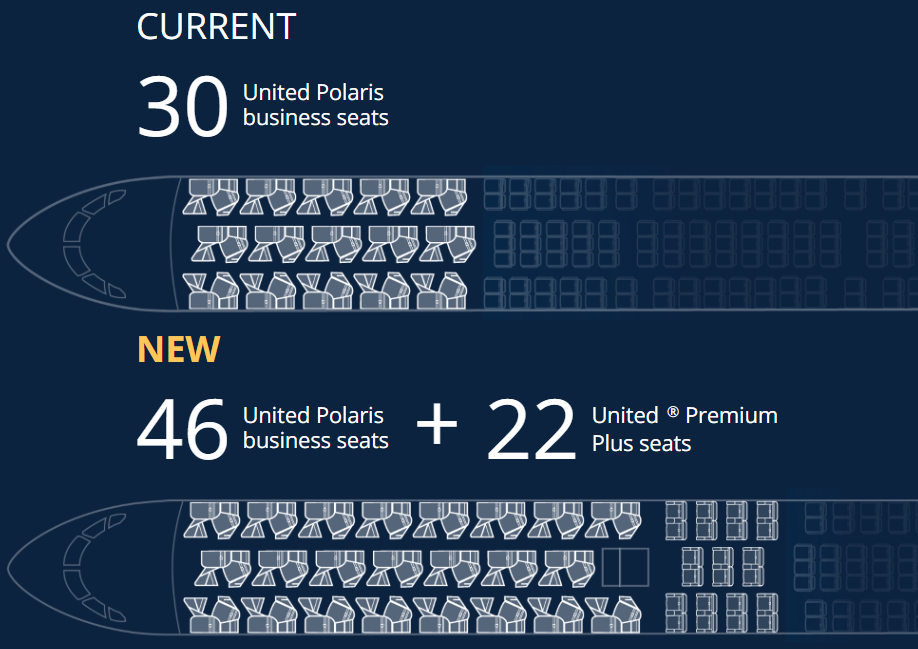
New Premium Regional Jets – “CRJ 550”
United is introducing a new configuration of the Bombardier CRJ-700 (CR7) with just 50 seats (instead of 70). It’ll be called the CRJ-550 and feature 10 first class, 20 economy plus, and 20 economy seats and will be operated by GoJet before the end of the year.
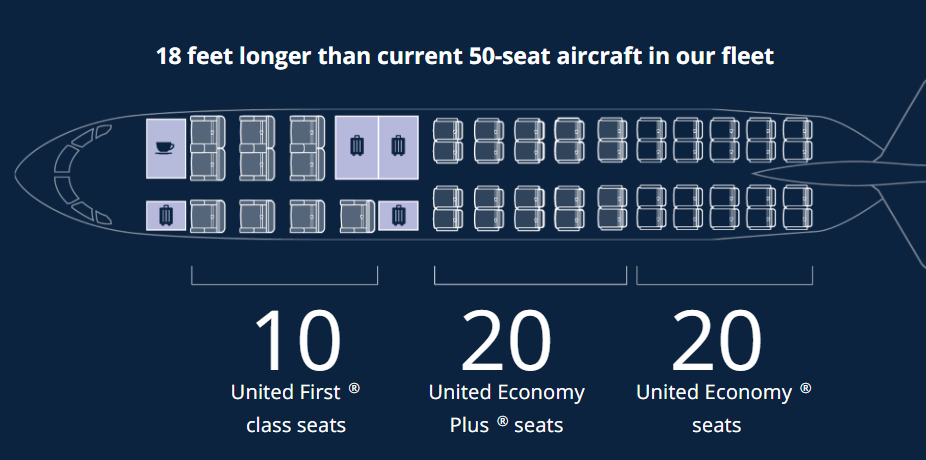
There will be four closets for storage, helping avoid gate checking of carry on bags.
There will also be a “self-serve beverage and snack station” for first class passengers. Under 14 CFR § 121.391 flight attendant staffing is required at 1 per 50 passengers, though readers more familiar with the requirements can speak to whether the gross payload of the aircraft will make it eligible to staff with just one cabin crew.
The first announced route for this new configuration is Chicago – Northwest Arkansas Regional Airport (Walmart is headquartered in Bentonville). After building up Chicago routes we’ll likely see it operating from Newark. United plans to operate the aircraft on certain premium-heavy routes under 900 miles, suggestive of the lack of need for a meal and perhaps underscoring a self-serve model. The airline has also just removed one flight attendant from international business class.
This week Jason Rabinowitz wrote at Runway Girl that United had made its regional passenger experience mirror mainline. My takeaway from the piece was just that United wifi didn’t work on United’s regional jets, either (which has been my experience). Ultimately however the regional moves here, while incurring tradeoffs and likely not driven by passenger experience goals, may be positive customers overall.
What is United Trying to Be?
United cuts flight attendant staffing in premium cabins, cuts meal service on many domestic flights in first class only to bring it back somewhat amidst complaints, while adding premium seats. United’s Polaris lounges are nicer than anything I ever thought possible from the airline while their premium seats aren’t as good as those offered by competitors.

They’re going premium heavy while squeezing inches elsewhere, and they were one of the first to adopt uncomfortable slimline seats in back and have gone 10-abreast on Boeing 777s and 9-abreast on 787s in coach.
The inflight has been inconsistent as well, with little move to change that. Even their announcement of free live TV refers only to legacy Continental 737s — rather than a plan to roll out live TV across the rest of their fleet.
United’s strategy has been to grow the airline, reversing cuts to the domestic network from the Smisek era, and to take advantage of premium demand in well-performing hub cities like San Francisco and New York (Newark), while shaving cost wherever they can. This move seems consistent with that framework.


One thing I like about this move United was installing televisions in the headrest section. This is a good move for people not only looking to look at TV before they fall asleep, but could possibly use this option as a means of checking email and surfing the web if they don’t have their laptops readily available. Your thoughts on this? 🙂
Any chance this means the return of international business awards, domestic first awards and advance domestic upgrade seats availability, or is that just wishful thinking?
” as well as adding first class seats to Airbus A319 and A320s where they’ve had fewer seats up front than competitors”
Too bad American has decided to match United with only 8 F seats on the A319 and 12 on the A320. 🙁
@Gary, Why is United reducing capacity on a plane from 70 to 50 seats? That is an unusual move. Pure speculation, but I’m guessing it may have to do with union contracts.
United mainline pilots may have a claim for any work on planes over 50 passengers. Possibly, limiting passengers to 50 makes it feasible for GoJet to fly the planes under its labor agreement.
In the 90s and early 2000s, purely to avoid the mainline pilot’s contract, Northwest flew Avro Regional Jets configured for 69 total passengers with 16 huge seats and extra leg room in first class. The CRJ-550 looks to he just a passenger friendly as those four holers. Upgrades were a piece of cake even for lowly sivers and companions.
IMHO, this takes some guts on both United and GoJet’s behalf.
Take a barely economically plane, remove 20 revenue seats (and yes, likely a crew member) and hope to make it back in the premium revenue across 10 J seats and a few pennies on some E+ seats.
.. when the whole point of United flooding the market with 50-seaters was to increase service into a small and short ORD/IAD/etc. feeder markets.
While a great passenger experience move (better improve the food and train their FA too), a dumb business move overall. Anyone remember Comfort Class at TWA? and I did fly the Avro’s with NWA upfront a number of times. Every time one of these airlines decides to remove seats, they put them right back in 2 years later. If fuel prices go up again or we enter a recession, United will be the first one showing red ink on their income statement. Bad move overall, Kirby’s job is on the line with this move and they will regret this in a few years. If I am wrong, AA and DL will need to follow suit, but I don’t think I am.
While UA is oddly settling to have a poorer Int’l Business Class experience than AA/DL, and while UA has equally crappy and hard slimline seats in Economy, there is second component of UA’s “Premium Heavy” strategy (beyond more biz class seats) that doesn’t get much attention and should! Has anyone counted recently the sheer number of Economy Plus seats on UA planes versus the number of MCE seats on AA planes? The difference is huge! For us FF that don’t get upgraded regularly domestically or internationally, my chances of getting a good Economy Plus seat on any given UA flight are exponentially higher than getting a good MCE seat on any given AA flight–especially on last-minute bookings.
If you doubt this, just take a few minutes and look at seat maps for an A319/320, a B737 (any model), a 757 or most wide bodies and count the number of PE seats on UA versus the MCE seats on AA for a similar aircraft. It’s incredible.
For me, it’s become enough in 2019 to say goodbye to my 5 years of EXP at AA and go back to UA after swearing them off 5 years ago. What have you done for me lately? As an elite economy passenger, UA Economy Plus is winning this one hand’s down.
Nobody’s talking about Cargo here. On the 767’s less customer baggage will mean more space for commercial cargo. I bet there’s a good upside there too and United can probably make more with paying cargo in the hold than customer’s baggage..
The MCE and EP discrepancy is due to the USAir planes. One the remodel is complete, they will be on par. If you fly often on AA (Plat or higher) getting a MCE seat at booking is not an issue, even on the old USAir metal.
@Sun Viking, I’ve got to totally disagree with you. The MCE shortage on AA isn’t just a “legacy US” problem. Just look at all of the seat maps on legacy AA 737-800s, 757s–and even 777-300ER wide bodies versus UA’s comparable planes. I’ll save you some time:
AA 737-800: 30 MCE versus UA 737-800: 42-54 Economy Plus
AA 757 (Domestic): 32 MCE versus UA 757 (Domestic): 52 EP
AA 737-300: 28 MCE versus UA 777-300: 102 EP
Not even close.
Nothing that AA is doing to densify its planes (legacy AA or US), add Premium Economy or anything else is narrowing the gap on MCE seats versus UA Economy Plus seats. And making MCE matters even worse….AA ruins its exit rows by putting tray tables in the armrests, making them almost too narrow to sit in…UA generally doesn’t make that stupid mistake.
Wow – United heading the same direction as Delta. As an AA EXP looking to make a switch next year I now have two better options to consider. Still hoping AA will reverse course by then on OASIS and densification, but not holding my breath…
This still won’t make me fly Polaris when other options, namely a foreign carrier’s first or business class , is available.
The passenger experience is so much better on foreign carriers. Even in their own markets, the Asian carriers can manage to serve a full hot (good) meal (from a choice of 3) , on an 80 minute flight with no problem , and business class full.